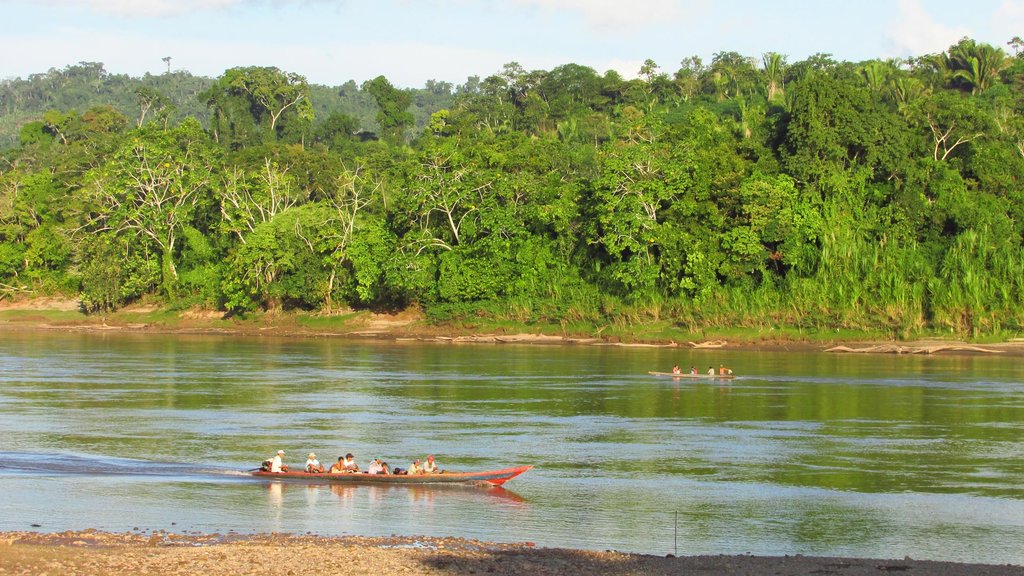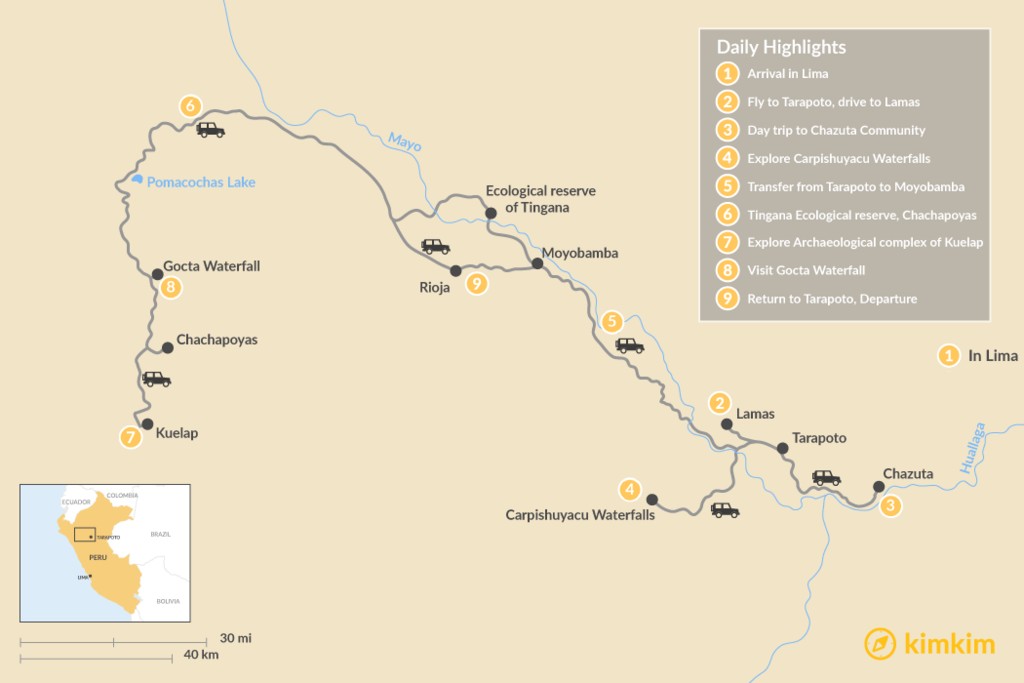Highlights
- Explore Kuelap, the “Machu Picchu of the North"
- Enjoy a trek in the jungle
- Visit Gocta, one of the ten highest waterfalls in the world
- Go on a chocolate tasting tour
- Visit the community of Lamas in the folkloric capital of San Martin
- Stay overnight in a nature reserve
Map overview

Brief itinerary
| Day | Highlights | Overnight |
|---|---|---|
| Day 1 | Arrival in Lima | Lima |
| Day 2 | Arrival in Tarapoto - Native Community of Lamas | Tarapoto |
| Day 3 | Chazuta Community and Cocoa Road | Tarapoto |
| Day 4 | Carpishuyacu Waterfalls - Thermal baths of San José | Tarapoto |
| Day 5 | Transfer Tarapoto to Moyobamba - Ecological reserve of Tingana | Tingana Reserve |
| Day 6 | Transfer Ecological reserve of Tingana - Chachapoyas | Chachapoyas |
| Day 7 | Archaeological complex of Kuelap | Chachapoyas |
| Day 8 | Gocta Waterfall (771 m high) | Cocachimba Gocta |
| Day 9 | Return to Tarapoto - Stop at the Orchid Center Waqanki |
Detailed itinerary
Day 1: Arrival in Lima

¡Bienvenidos! Welcome to Lima, Peru's largest city and central metropolitan hub, and home to one-third of the country's population. Located at the site of a pre-Columbian indigenous Ychsma settlement, which was conquered by the Inca empire in the 15th century and later by the Spanish conquistadores, Lima has a fascinating history and a diverse mix of cultures. Amerindian, European, Afro-Peruvian, and Asian—especially Chinese and Japanese—influences make Lima a dynamic and exciting city to explore.
Lima's breezy location on the Pacific Ocean and mild desert climate make it the perfect city for exploring on foot. Head downtown to mingle with locals, stretch your legs, and grab a bite to eat in one of the many award-winning restaurants.
Suggested activities include:
-
Explore the historic center of Lima, a UNESCO World Heritage Site packed with fascinating Spanish architecture. Start with a scenic tour of the colonial downtown, which emanates from the main square. Stroll over to the 16th-century Cathedral, which took 80 years to construct and was built in the grandiose style of the Spanish Empire.
-
Visit the Casa Aliaga, a colonial mansion granted by chief conquistador Francisco Pizarro to Jerónimo de Aliaga, one of his captains, in 1535. This is the only house from that era that still belongs to the same family.
-
Stroll around the Pueblo Libre district to the privately owned Larco Museum of pre-Columbian art, housed in a beautifully restored viceregal mansion built over a 7th-century pre-Columbian pyramid. The museum boasts a vast pre-Colonial collection of gold and silver artifacts, as well as pieces of erotic art.
-
In the evening, head to the eclectic "Love Park" in the upscale coastal district of Miraflores, where you can admire a huge kissing statue and beautiful mosaic walls. The park is built on the cliffs of Chorrillos and is a perfect place to enjoy a spectacular sunset over the Pacific.
- Enjoy a nightcap at an open-air cafe or restaurant in the diverse Miraflores neighborhood.
Day 2: Arrival in Tarapoto - Native Community of Lamas

Head to the Lima airport for your transfer flight to Tarapoto.
Upon arrival, you'll be picked up at the airport and transferred to your hotel for lunch. We then travel 45 minutes to visit the native community of Lamas, known as the folkloric capital of the San Martin region. The inhabitants are descendants of the Chanca culture, migrants from the central Andes of Peru, who have preserved their traditions as well as their Quechua language and clothing. Their houses have the distinction of being built without windows.
We'll then visit the main square, the Los Chancas museum, the natural lookout La Cruz, and the neighborhood Wayku ethnic center. Afterward, we'll return to Tarapoto.
Day 3: Chazuta Community and Cocoa Road

We travel 2 hours to Chazuta district, 60 km southeast of Tarapoto, on the left bank of the Huallaga River. Along the roadside, we will observe the cocoa crops and visit a demonstration plot with the different production stages of organic cocoa. We can participate in the harvest, then continue to the Museum of Art: an Exhibition of woodworks alluding to their legends. Then, time for lunch!
After lunch, we'll visit the cultural and craft center Wasichay. You'll find showrooms with ceramics that preserve their ancestral characteristics, funeral urns, demonstration of making pottery. Next, we will visit a factory where they make ecological paper to see the process with organic materials such as banana and coconut.
Next up is a visit to the chocolate factory “Mishki cacao” for a demonstration of the manufacturing process of the cocoa cream. We'll also be able to taste the products. Then we continue to the central park district, visit the urns in the place where they were discovered.
Day 4: Carpishuyacu Waterfalls - Thermal baths of San José

We'll travel one hour (33 km) to the town of San Jose, where our adventure begins. We'll walk 50 minutes in the dense vegetation of the jungle. We can see frogs, butterflies, orchids, sloths, birds, timber and medicinal plants. We arrive at the waterfalls to see two drops of 6 meters and a pool with a depth of 4 meters. Here, you'll have some free time to enjoy and explore. Fifteen minutes after our return, we'll reach the thermal baths for a dip in 40° C waters.
Day 5: Transfer Tarapoto to Moyobamba - Ecological reserve of Tingana
Chat with a local specialist who can help organize your trip.

We travel two hours to Moyobamba city (860 m). On the way, we will observe plantations: cocoa, coffee, and rice. We'll continue one hour to Puerto La Boca, and then we continue on the waterway for one hour, crossing the Mayo River. We then reach the ecological reserve of Tingana for lunch.
After lunch, we'll sail the Abisado River and observe the rich flora: amphibious trees, aguaje trees (Mauritia Flexuosa) and renaco (Ficus Sp) Ferns, lianas and orchids. We'll also have a chance to see birds, fish, reptiles, and other insects. Among the prominent mammals, you'll find otters, monkeys (friar, pichico, coto, omeco) sloth bear, squirrel, fish as the shitari, tilapia and carachama. In the reserve, there are over 120 species of birds, such as the tarahui, flauterillo, toucan, manacaraco, ishaco and Martin pescador.
Day 6: Transfer Ecological reserve of Tingana - Chachapoyas

Today, we'll take a short walk through the reserve, observing the flora and fauna. Then a return trip to Moyobamba city for lunch. We then continue ascending to the Amazonian Andes and pass the Pomacochas Lake. We then reach Huembo, with a chance to see the spatuletail hummingbird, an endemic bird of the region. Finally, we'll travel through the Uctubamba Valley and arrive in Chachapoyas city (2235 m).
Day 7: Archaeological complex of Kuelap

We descend through the valley of the Uctubamba River for one hour. On the way, we stop to observe the archaeological Pre-Inca site of Macro (circular stone constructions, with diamond decorations).
We continue 20 minutes to El Tingo district, where we will board the bus to the cable car. Then we travel 10 minutes to the platform, board the cable car and experience this breath-taking ride for 20 minutes (4 km). We'll arrive at the tourist center La Malca. From here, it is a 2 km walk to fortified Kuelap (3000 m).
Kuelap was built in the 6th century in an area of 6 hectares, with more than 500 circular buildings. These are decorated with friezes, diamonds and stylized beings, representing the major deities. After exploring the ruins, we'll have lunch in a local restaurant and then journey back to the Chachapoyas city.
Day 8: Gocta Waterfall (771 m high)

Today, we descend the valley of the Uctubamba River for about one hour before arriving at the Cocachimba community (2,000 m).
Walk and/or ride 2.5 hours (6 km) to the waterfall. On our way, we can observe the local agricultural activity. We cross amid the dense vegetation that is typical in cloud forests, home to the spatuletail hummingbird, the gallito de las rocas (national bird), orchids and bromeliads. Once we reach the base of the waterfall, you can dip in the waters if you're brave.
Day 9: Return to Tarapoto - Stop at the Orchid Center Waqanki

We'll travel back to Tarapoto city through the Amazon plains by the Inter-Oceanic Highway North. During the trip, we pass the Pomacochas Lake, from there we continue to the Rioja city for lunch. From there, we continue our journey along the Mayo River and reach the town of Moyobamba where we'll visit the Orquideario Waqanki. Finally, you'll be transferred to the airport or your hotel at the end of your journey.


